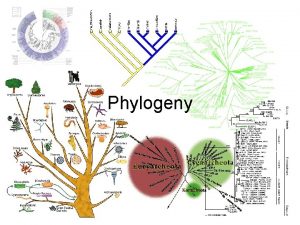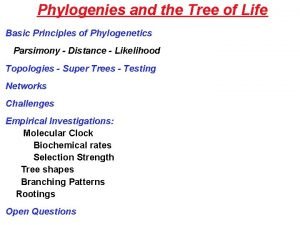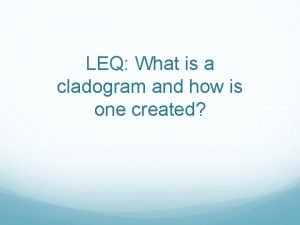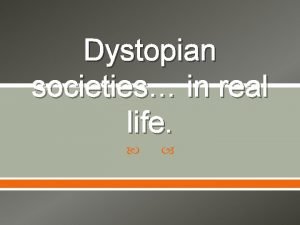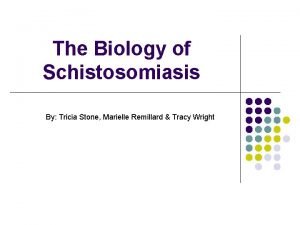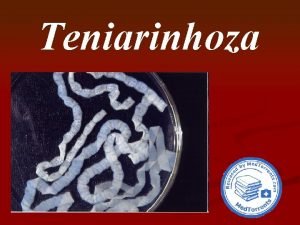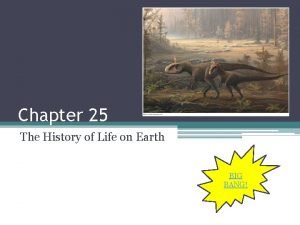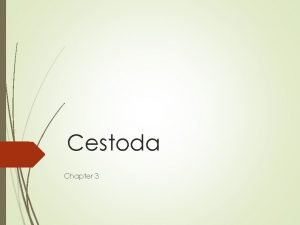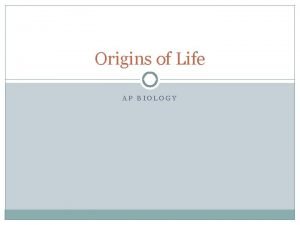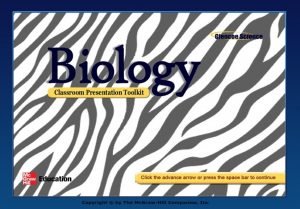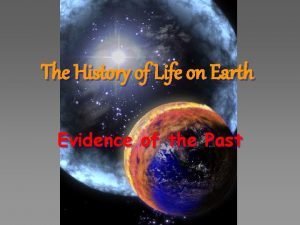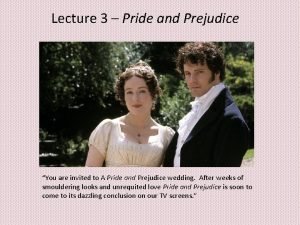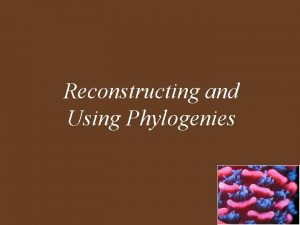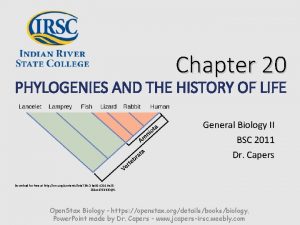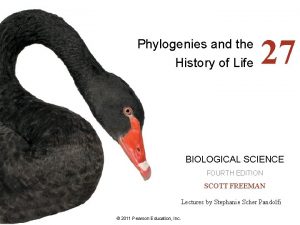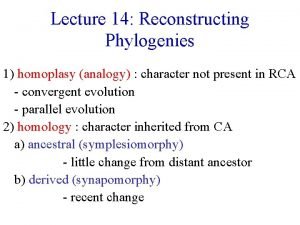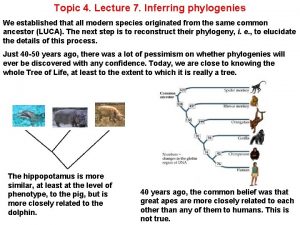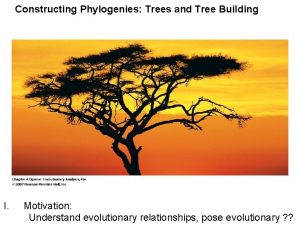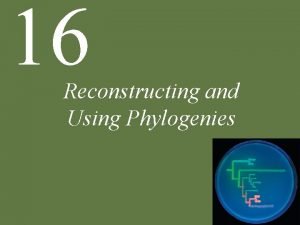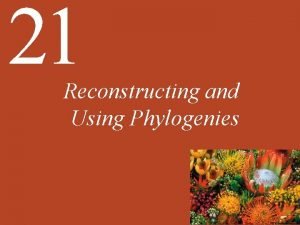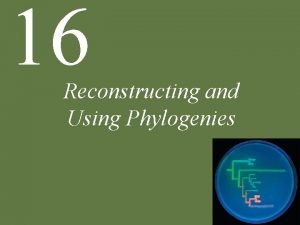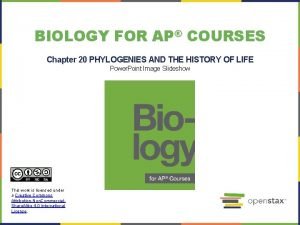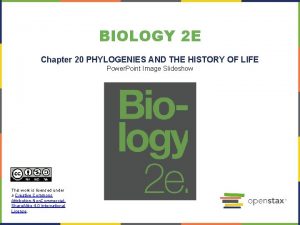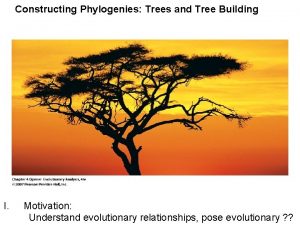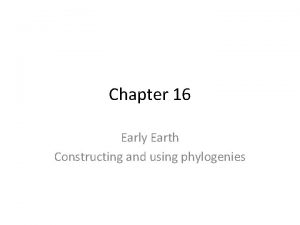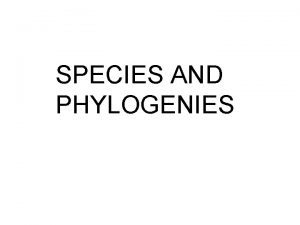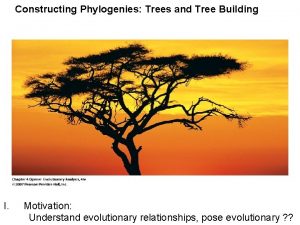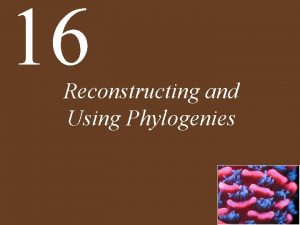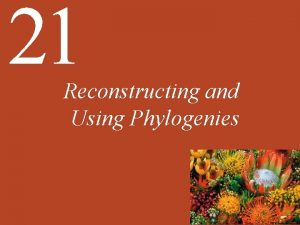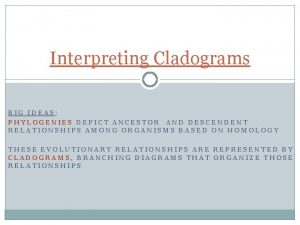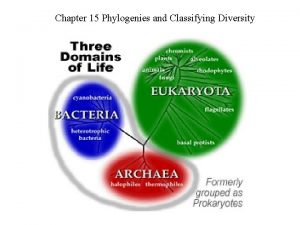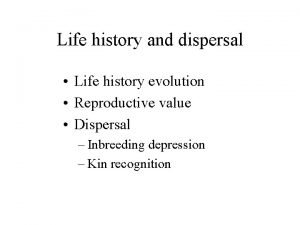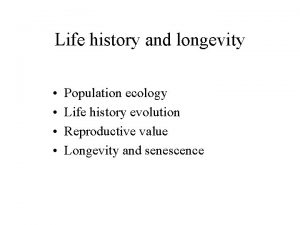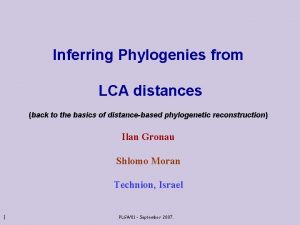25 Phylogenies and the History of Life Lecture




































































































- Slides: 100

25 Phylogenies and the History of Life Lecture Presentation by Cindy S. Malone, Ph. D, California State University Northridge © 2017 Pearson Education, Inc.

Chapter 25 Opening Roadmap. © 2017 Pearson Education, Inc.

Introduction • Biologists must consider profound change in the nature of life on Earth over vast periods of time • Biologists use two major analytical tools to reconstruct the history of life: 1. Phylogenetic trees 2. The fossil record • Can be used separately or in combination © 2017 Pearson Education, Inc.

Tools for Studying History: Phylogenetic Trees • The evolutionary history of a group of organisms is called a phylogeny • A phylogenetic tree • Is a graphical summary of this history • Shows evolutionary relationships among genes, species and higher taxa • The most universal phylogenetic tree is the tree of life • Depicts evolutionary relationships among all living organisms © 2017 Pearson Education, Inc.

Tools for Studying History: Phylogenetic Trees • Phylogenetic trees have revolutionized the study of evolution • Can be used in taxonomy to define species • Can be used in medicine to study the spread of disease • Can aid in identifying species that are a conservation priority • Can be used in agriculture to identify wild species for breeding with current crops © 2017 Pearson Education, Inc.

Tools for Studying History: Phylogenetic Trees • A branch represents a population through time • A node (fork) represents a point where a branch splits— that is, hypothetical most recent ancestor • A tip (terminal node) represents the endpoint of a branch —that is, a living or extinct taxon © 2017 Pearson Education, Inc.

Tools for Studying History: Phylogenetic Trees • The root is the most ancestral branch in the tree • An outgroup is a taxon that diverged before the taxa that are the focus of the phylogeny and helps to root the tree • A polytomy is a node that divides into 3 or more branches suggesting that not enough data were available to resolve which taxa are most closely related © 2017 Pearson Education, Inc.

Tools for Studying History: Phylogenetic Trees • Important point: Taxa are always located on branch tips, never within the tree, because none of the taxa are presumptive ancestors of others • Instead, closely related taxa are depicted as sister groups that share a recent common ancestor © 2017 Pearson Education, Inc.

Tools for Studying History: Phylogenetic Trees • Nodes represent speciation events • Branches of trees can rotate at each node, so positions of labels at tips of the tree are not useful in determining relationships • The number of nodes are not useful for determining relationships because, they depend on the number of taxa included in the tree © 2017 Pearson Education, Inc.

How Do Biologists Estimate Phylogenies? • As with other measurements, the relationships among taxa cannot be known with absolute certainty • Relationships depicted in phylogenetic trees must be estimated from the best available data • Phylogenetic trees are hypotheses that can be tested © 2017 Pearson Education, Inc.

Creating the Data Matrix • The first step in inferring evolutionary relationships to determine which taxa to compare and which characteristics to use • A character or trait is any genetic, morphological, physiological, or behavioral characteristic to be studied • Each character has two possible states: present (1) or absent (0) © 2017 Pearson Education, Inc.

Creating the Data Matrix • An outgroup is a sister group that shares a recent common ancestor with taxa being studied, but is not part of the study group • Is used to establish whether a trait is ancestral or derived © 2017 Pearson Education, Inc.

Creating the Data Matrix • An ancestral trait is a character that existed in an ancestor • A derived trait is one that is a modified form of the ancestral trait, found in a descendant • Originate via mutation, selection, and genetic drift • Ancestral and derived traits are relative—that is, they depend on what taxa are being compared © 2017 Pearson Education, Inc.

Creating the Data Matrix • Outgroups also evolve that do not represent ancestors of other taxa in the tree • Therefore, multiple outgroups are often used to estimate phylogenetic relationships © 2017 Pearson Education, Inc.

Figure 25. 1 a (a) Data matrix Characters Skull Limbs Hair Lactation 1 0 0 0 Lungfish (outgroup) 1 1 0 0 Lizard 1 1 Dog 1 1 Human © 2017 Pearson Education, Inc.

Table 25. 2 © 2017 Pearson Education, Inc.

Figure 25. 1 b (b) Phylogenetic tree inferred from the data Most recent common ancestor Lungfish Skull Limbs Hair, Lactation Synapomorphies © 2017 Pearson Education, Inc. Lizard Dog Human

Using the Data Matrix to Estimate a Tree • Cladistic approach was the first method to infer phylogenetic trees • Introduced by Willi Hennig in the 1960 s • Based on reconstructing relationships among species by identifying synapomorphies (shared derived traits) © 2017 Pearson Education, Inc.

Using the Data Matrix to Estimate a Tree • Synapomorphies • Traits found in two or more taxa that are present in their most recent common ancestor but missing in more distant ancestors • Allow biologists to recognize monophyletic groups— called clades or lineages • A monophyletic group is an evolutionary unit that includes an ancestral population and all of its descendants, but no others © 2017 Pearson Education, Inc.

Using the Data Matrix to Estimate a Tree • There are several possible complications to resolve when inferring a tree • Traits may be similar due to independent evolution and not common ancestry • A reversal in a character change may occur, creating the appearance that no change occurred • Example: Loss of limbs in snakes © 2017 Pearson Education, Inc.

Using the Data Matrix to Estimate a Tree • Species may form monophyletic groups based on one trait but part of a different monophyletic group using another trait • Example: Snakes and lizards group together based on presence of an amniotic egg but not based on presence of limbs © 2017 Pearson Education, Inc.

Using the Data Matrix to Estimate a Tree • Parsimony • Used to identify the most likely tree • Is a principle of logic • States that the most likely explanation or pattern is the one that implies the least amount of change • Computer programs can compare theoretically possible branching patterns to determine the most parsimonious tree • The tree with the least evolutionary change is likely the one that most accurately reflects what occurred during evolution © 2017 Pearson Education, Inc.

Using the Data Matrix to Estimate a Tree • Other methods exist • Example: Genetic distance methods, likelihood methods, and Bayesian methods • All have a similar function—to serve as a “filter” to identify optimal trees • Some researchers use multiple methods to increase confidence in their results © 2017 Pearson Education, Inc.

Using the Data Matrix to Estimate a Tree • Trees (called cladograms) that are created using cladistics focus on branching patterns • Branch length is arbitrary • Other methods create trees where branch length represents genetic distance or time since divergence • Scale bars are present in these trees © 2017 Pearson Education, Inc.

Table 25. 3 © 2017 Pearson Education, Inc.

How Can Biologists Distinguish Homology from Homoplasy? • Homology occurs when traits are similar due to shared ancestry • Homoplasy occurs when traits are similar for reasons other than common ancestry • Convergent evolution is a common cause of homoplasy • Occurs when natural selection favors similar solutions to similar environmental pressures • Within a species, some characteristics may be homologous with characteristics in other species, while others may be convergent © 2017 Pearson Education, Inc.

Are the Flowers of Water Lilies Homologous or Convergent? • Many plants have reproductive structures called flowers • They are diverse in appearance but have the same function—to house male and female gametes and facilitate fertilization • Phylogenetic evidence—water lilies and roses are in a monophyletic group called angiosperms, where all lineages have flowers • Suggests that flowers are inherited from a common ancestor that also had flowers © 2017 Pearson Education, Inc.

Are the Flowers of Water Lilies Homologous or Convergent? • Structural evidence—most flowers are built upon the same template • Genetic and developmental evidence—the genetic tool kit and developmental patterns for development of floral structures are similar in different plants involving the same genes • The agreement of all four types of data provides strong evidence that flowers in diverse plant types are homologous © 2017 Pearson Education, Inc.

Figure 25. 2 Ferns Pine trees ANGIOSPERMS Flowers The common ancestor of water lilies and wild roses had flowers © 2017 Pearson Education, Inc. Water lilies These descendants also have flowers Wild roses

Are Streamlined Bodies in Dolphins and Ichthyosaurs Homologous or Convergent? • Ichthyosaurs (extinct aquatic reptiles) and dolphins are very similar • Streamlined bodies • Large dorsal fins and flippers • Phylogenetic analysis, however, indicates that these similarities are not due to common ancestry • Dolphins are in the mammal clade and ichthyosaurs are closely related to lizards • Sister groups to dolphins and ichthyosaurs do not have the same traits • The similarities result from convergent evolution © 2017 Pearson Education, Inc.

Figure 25. 3 Synapsids Monotremes Common dolphin Marsupials Dolphins The common ancestor of dolphins and ichthyosaurs did not have a streamlined body or fins and flippers Dolphins and ichthyosaurs evolved their similar traits independently Rodents Ichthyosaur Dinosaurs Ichthyosaurs Lizards © 2017 Pearson Education, Inc. 0. 5 m Primates 1 m

Whale Evolution: A Case Study • Let’s apply what we’ve discussed about phylogenetic trees and homology to an interesting case study • Where do whales belong on the tree of life? © 2017 Pearson Education, Inc.

Data Set 1: A Phylogeny Based on Morphological Traits • Hippos, cows, deer, and pigs are artiodactyls • These mammals have • Hooves • An even number of toes • An unusual pulley-shaped ankle bone (astragalus) • Traditionally, phylogenetic trees based on morphological data place whales as the outgroup to artiodactyls • They do not have an astragalus © 2017 Pearson Education, Inc.

Figure 25. 4 a (a) Data set 1 (morphological traits): Whales diverged before the origin of artiodactyls. Perissodactyls (horses and rhinos) Whale ARTIODACTYLS Camel Peccary Gain of pulley-shaped astragalus Pig Hippo Astragalus (ankle bone) Deer Cow © 2017 Pearson Education, Inc.

Data Set 2: A Phylogeny Based on DNA Sequence Data • DNA sequence data suggest a closer relationship between whales and hippos than between whales and other artiodactyls • The tree with whales and hippos as sister taxa would require two changes to the astragalus trait • The evolution of the astragalus in artiodactyls • The loss of the astragalus in whales • It is less parsimonious than a tree with just one change • The gain of the astragalus, with whales as an outgroup © 2017 Pearson Education, Inc.

Figure 25. 4 b (b) Data set 2 (DNA sequences): Whales and hippos share a common ancestor. Perissodactyls (horses and rhinos) ARTIODACTYLS Camel Gain of pulleyshaped astragalus Peccary Pig Hippo Whale Loss of pulleyshaped astragalus Deer Cow © 2017 Pearson Education, Inc.

Data Set 3: Transposable Elements • DNA sequences called SINEs (short interspersed nuclear elements) occasionally insert themselves into mammalian genomes • Gene sequences show that whales and hippos share several SINE genes that are absent in other artiodactyl groups • The chance of the same SINE inserting into the same place in the genome of two different species is incredibly small • These SINEs are derived characters and support the hypothesis that whales and hippos are closely related © 2017 Pearson Education, Inc.

Figure 25. 4 c (c) Data set 3 (presence and absence of SINEs): Supports the close relationship between whales and hippos. Locus Cow Deer Whale Hippo Pig Peccary Camel © 2017 Pearson Education, Inc. 1 = SINE present 0 = SINE absent ? = still undetermined Whales and hippos share four unique SINEs (4, 5, 6, and 7)

Conclusion: Whales Are Closely Related to Hippos • Most biologists accept the hypothesis that whales descended from land-dwelling artiodactyls that feed in shallow water • In 2001, fossil artiodactyls were found that also support this hypothesis. They have • An unusual ear bone found only in whales • A pulley-shaped astragalus • The combination of DNA sequence data and fossil data clarified the relationship between whales and artiodactyls © 2017 Pearson Education, Inc.

Tools for Studying History: The Fossil Record • The fossil record provides the only direct evidence about • What organisms that lived in the past looked like • Where they lived • When they existed • A fossil is the physical evidence from an organism that lived in the past • The fossil record is the total collection of fossils that have been found throughout the world © 2017 Pearson Education, Inc.

How Do Fossils Form? • Most of the processes that form fossils begin when part or all of an organism is buried in some type of sediment © 2017 Pearson Education, Inc.

How Do Fossils Form? • Once burial occurs, several things can happen: • Intact fossils form when decomposition does not occur and organic remains are preserved • Compression fossils form when sediments accumulate on top of the material and compress it into a thin carbonaceous film • Cast fossils form when the remains decompose after burial and dissolved minerals create a cast in the remaining hole © 2017 Pearson Education, Inc.

How Do Fossils Form? • Permineralized fossils form when the remains decompose slowly and dissolved minerals slowly infiltrate the cells’ interiors and harden into stone • Trace fossils form when sedimentation and mineralizations preserve indirect evidence of an organism © 2017 Pearson Education, Inc.

Table 25. 4 © 2017 Pearson Education, Inc.

How Do Fossils Form? • If the species is new, researchers estimate its age based on the age of nearby rock layers © 2017 Pearson Education, Inc.

How Do Fossils Form? • Fossils form only under ideal conditions • They must be buried rapidly • They must decompose slowly • Fossilization is an extremely rare event, and the discovery of individual fossils is also rare • There are 12 specimens of Archaeopteryx, the first birdlike dinosaur to appear in the fossil record • As far as researchers currently know, only one out of every 200, 000 individuals were fossilized and discovered © 2017 Pearson Education, Inc.

Limitations of the Fossil Record • The fossil record has several limitations: 1. Habitat bias • Organisms that live where sediment is actively being deposited (e. g. , beaches, swamps) are more likely to fossilize than are organisms in other habitats • In these habitats, burrowing organisms are more likely to fossilize compared to organisms living aboveground © 2017 Pearson Education, Inc.

Limitations of the Fossil Record 2. Taxonomic and tissue bias • Some organisms (e. g. , those with hard parts such as bones or shells) are more likely to decay slowly and leave fossil evidence • Tissues with a tough outer coat that resists decay (e. g. , pollen) fossilize more readily 3. Temporal bias • More recent fossils are more common than ancient fossils © 2017 Pearson Education, Inc.

Life’s Time Line 4. Abundance bias • Organisms that are abundant, widespread, and present for a long time leave evidence much more often than do species that are rare, local, or ephemeral © 2017 Pearson Education, Inc.

Life’s Time Line • It is difficult to date the origin of life precisely • Our best estimates • Earth started to form about 4. 6 billion years ago • Life began around 3. 5 billion years ago © 2017 Pearson Education, Inc.

Life’s Time Line • Researchers • Divide Earth’s history into segments called eons, eras, periods, and epochs • These record “evolutionary firsts” such as the appearance of important new lineages or innovations • The dates likely underestimate when events occurred or lineages appeared, because species can exist for a long time before leaving any fossil evidence © 2017 Pearson Education, Inc.

Life’s Time Line • Originally, geologists used distinctive rock formations or fossilized organisms to identify the boundaries of time intervals • Radiometric dating allowed researchers to assign absolute dates—expressed as years before the present—to events and species in the fossil record © 2017 Pearson Education, Inc.

Figure 25. 5 Millions of years ago 541 mya Phanerozoic Eons Present First appearances See Figure 25. 6 First bilaterally symmetric animals Oxygen levels begin rapid rise First sponges First red algae; first evidence of sexual structures Proterozoic Eon First photosynthetic eukaryotes Precambrian First eukaryotic fossils First rocks containing evidence of abundant oxygen (in atmosphere and ocean) First cyanobacteria fossils 2500 First evidence of oxygenic photosynthesis Archaean Eon First evidence of photosynthetic cells Origin of life 4000 Hadean Eon 4570 © 2017 Pearson Education, Inc. First oceans; heavy bombardment (collisions with large asteroids and other bodies) from space ends Liquid water on Earth formation complete Moon forms Formation of solar system

Precambrian Era • The Precambrian era spans the interval from Earth’s formation (4. 6 billion years ago) to the appearance of most animal groups about 541 million years ago (mya) • It is divided into the Hadean, Archaean, and Proterozoic eons • In the Precambrian • Life was exclusively unicellular • Oxygen was virtually absent from the oceans and atmosphere for about 2 billion years, until the evolution of photosynthetic bacteria © 2017 Pearson Education, Inc.

Phanerozoic Eon • The Phanerozoic eon • Spans the interval between 542 mya and the present • Is divided into three eras—the Paleozoic, the Mesozoic, and the Cenozoic • These eras are divided into periods, which are divided into epochs © 2017 Pearson Education, Inc.

Phanerozoic Eon • The Paleozoic (“ancient life”) era • Begins with the appearance of most major animal lineages • Includes the initial diversification of animals, land plants, and fungi • Land animals first appear • Ends with the obliteration of almost all multicellular life -forms at the end of the Permian period © 2017 Pearson Education, Inc.

Phanerozoic Eon • The Mesozoic (“middle-life”) era • Begins with the end-Permian extinction events and ends with the extinction of dinosaurs between the Cretaceous and Paleogene periods • Dinosaurs and gymnosperms were the most dominant terrestrial vertebrates and plants, respectively © 2017 Pearson Education, Inc.

Phanerozoic Eon • The Cenozoic (“recent-life”) era • Divided into the Paleogene, Neogene, and Quaternary periods • Mammals and angiosperms were the largest terrestrial vertebrates and plants, respectively © 2017 Pearson Education, Inc.

Figure 25. 6 Periods Cenozoic Era Present 2. 6 23 mya Epoch Holocene Quaternary Pleistocene Pliocene Neogene Miocene Oligocene Eocene Paleogene Paleocene 66 Mesozoic Era Representative organisms Homo sapiens; first chimpanzees Earliest hominins Oldest pollen from daisy-family plants First apes First fully aquatic whales First horses; first primates; first rabbits/hares Cretaceous extinction First bee; first ant First magnolia-family plants First water lilies First centric diatoms First angiosperm (flowering plant) Cretaceous 145 First appearances First bird-like reptile First placental mammals First tyrannosaurid dinosaur Jurassic Triassic extinction 201 First mammals 252 Phanerozoic Eon Triassic First dinosaurs First nectar-drinking insects First vessels in plants Permian extinction Permian 299 Pennsylvanian Origin of amniotes Carboniferous First basidiomycete fungi Mississippian Paleozoic Era 359 First seed plants; first plants with leaves First tetrapods (amphibians) First winged insects Devonian 419 Devonian extinction First tree-sized plants First ferns, vascular plants, ascomycete fungi, lichens First insects First fish with jaws Silurian First bony fish 443 Ordovician First mycorrhizal fungi (Glomales) First land plants 485 First bryozoans (most recent origin of an animal phylum) Cambrian 541 © 2017 Pearson Education, Inc. Arthropods diversify; first echinoderm First arthropods, mollusks, vertebrates, other phyla Ordovician extinction

Phanerozoic Eon • We are currently in the Holocene epoch • Many scientists have called for recognition of a new epoch, the Anthropocene (“human-epoch”), to reflect human-induced change on Earth © 2017 Pearson Education, Inc.

Phanerozoic Eon • The fundamental message of the time line is that of constant change of life on Earth • The water chemistry, atmosphere, climate, and continental positions also changed dramatically © 2017 Pearson Education, Inc.

Adaptive Radiation • An adaptive radiation is the rapid production, from a single lineage, of many descendant species • These descendant species have a wide range of adaptive forms • May be observed as the sudden appearance of related diverse species in the fossil record or inferred by phylogenetic analysis © 2017 Pearson Education, Inc.

Adaptive Radiation • Example: The 30 species of Hawaiian silverswords, which evolved from tarweed • They fulfill the three hallmarks of an adaptive radiation: 1. They are a monophyletic group 2. They speciated rapidly 3. They diversified ecologically into many niches • The term niche describes the range of resources that a species can use and the range of conditions that it can tolerate © 2017 Pearson Education, Inc.

Figure 25. 7 Tarweeds Dubautia latifolia HAWAIIAN SILVERSWORDS Vine Mat A tarweed colonized Hawaii here Rosette © 2017 Pearson Education, Inc. Dubautia scabra Argyroxiphium sandwicense

Why Do Adaptive Radiations Occur? • Two general mechanisms can trigger adaptive radiations: 1. Extrinsic factors such as favorable new conditions in the environment 2. Intrinsic factors such as evolution of key morphological, physiological, or behavioral traits © 2017 Pearson Education, Inc.

Ecological Opportunity • Ecological opportunity—the availability of more or new types of resources—has driven a wide array of adaptive radiations • Example: Few other flowering plants were on the Hawaiian Islands 5 mya, so silverswords could diversify into many vacant niches © 2017 Pearson Education, Inc.

Ecological Opportunity • Ecological opportunity—the availability of more or new types of resources—has driven a wide array of adaptive radiations • Example: Few other flowering plants were on the Hawaiian Islands 5 mya, so silverswords could diversify into many vacant niches • With few competitors, colonizing tarweed grew in a range of habitats • Some became specialized for growth in different niches through mutation, genetic drift, and natural selection © 2017 Pearson Education, Inc.

Ecological Opportunity • Example: Adaptive radiation of the 150 species of Anolis lizards of the Caribbean islands • These lizards • Thrive in a wide variety of habitats • Have diverse body sizes and shapes © 2017 Pearson Education, Inc.

Ecological Opportunity • Example (continued): • In most cases, a lizard’s size and shape correlate with its habitat • Species that live on tree twigs have short legs and tails to move efficiently on narrow surfaces • Species that live on tree trunks or the ground have long legs and tails to make them fast and agile on broad surfaces © 2017 Pearson Education, Inc.

Figure 25. 8 (a) Short-legged lizard species spend most of their time on the twigs of trees and bushes. Anolis insolitus Twig anole © 2017 Pearson Education, Inc. (b) Long-legged lizard species live on tree trunks and the ground. Anolis cybotes Trunk/ground anole

Ecological Opportunity • Example (continued): • Jonathan Losos and his colleagues used DNA sequence data to estimate Anolis phylogeny to test the hypothesis that a mini-radiation occurred on each Caribbean island. • An original colonizing population encountered no competitors • Therefore they could diversify, which resulted in efficient use of available resources by the descendant species © 2017 Pearson Education, Inc.

Ecological Opportunity • Example (continued): • They found that the lizards on each island were monophyletic • They inferred that the original colonist on each island was specialized for a particular niche • From different starting points, an adaptive radiation filled the same niches on the islands • This is an example of homoplasy by convergent evolution © 2017 Pearson Education, Inc.

Figure 25. 8 c (c) The same adaptive radiation of Anolis has occurred on different islands, starting from a different species of colonist. Colonization of Island: Hispaniola island by lizard living on trunks Trunk/crown and crowns © 2017 Pearson Education, Inc. Colonization Island: Jamaica of island by lizard living Twig on twigs Twig Trunk/ground Crown Trunk/ground Trunk/crown

Morphological, Physiological, or Behavioral Innovation • The evolution of a key trait may have triggered many important diversification events in the history of life • Example: • Flowers are a unique reproductive structure that helped trigger the diversification of angiosperms into over 250, 000 species (most species-rich lineage of land plants) • Feathers and wings gave some dinosaurs the ability to fly; today the bird lineage contains about 10, 000 species living in virtually every habitat on Earth © 2017 Pearson Education, Inc.

The Cambrian Explosion • Almost all organisms were unicellular for almost 3 billion years after life originated • The exceptions were lineages of small multicellular algae that appeared about 1 billion years ago • The first animals—early sponges—appeared around 635 mya • Then, 50 million years later, animals became larger and more complex • This diversification is known as the Cambrian explosion —the most spectacular evolutionary change in the history of life © 2017 Pearson Education, Inc.

The Cambrian Explosion • The Cambrian explosion is documented by three major fossil assemblages mainly from Canada, China, and Australia • Each fossil assemblage records a distinctive fauna —or collection of animal species © 2017 Pearson Education, Inc.

© 2017 Pearson Education, Inc. Phanerozoic Eon Cambrian Period Cambrian fossils Proterozoic Eon Ediacaran Period Figure 25. 9 Ediacaran fossils 1 cm 5 mm 541 mya 1 cm

Early Animal Fossils • Microfossils from the Ediacaran period • First animals to appear included tiny (less than 1 mm) sponges and corals • They were likely to have been filter feeders • First macroscopic fossils during the Ediacaran • Included sponges, jellyfish, comb jellies, fossilized burrows, tracks, and traces from unidentified animals • None have shells, limbs, heads, or feeding appendages • They likely were burrowing, floating, or immobile filter feeders © 2017 Pearson Education, Inc.

Early Animal Fossils • Cambrian macroscopic fossils • Included sponges, jellyfish, comb jellies, wormlike animals, arthropods, mollusks, echinoderms, and most other major animal phyla including chordates • These animals swam, burrowed, walked, ran, slithered, clung, or floated • They were predators, scavengers, filter feeders, and grazers • Filled many ecological niches found in marine habitats © 2017 Pearson Education, Inc.

Figure 25. 10 Early vertebrate © 2017 Pearson Education, Inc.

What Triggered the Cambrian Explosion? • Most recent common ancestor of all living animals may have arisen about 800 mya, before diversification occurred • Key developmental tool-kit genes likely evolved before diversification • So, what triggered the onset of the diversification? © 2017 Pearson Education, Inc.

What Triggered the Cambrian Explosion? • There are four non-mutually exclusive hypotheses: 1. Higher oxygen levels • This made aerobic respiration more efficient • Increased aerobic respiration is required to support larger, more active animals • Oxygen levels may have reached a threshold at the start of the Cambrian explosion 2. The evolution of predation • Predation exerted selection for shells, exoskeletons, rapid movement, and other defenses driving morphological divergence among prey © 2017 Pearson Education, Inc.

What Triggered the Cambrian Explosion? 3. New niches beget more new niches • Once animals could move off the ocean floor, they could exploit algae and other resources • The ability to exploit new niches created new niches for predators, driving speciation and divergence 4. New genes, new bodies • The earliest animals had few or no HOX genes • Gene duplication and diversification increased the number of Hox genes in animals • Made it possible for larger, more complex bodies to evolve © 2017 Pearson Education, Inc.

What Triggered the Cambrian Explosion? • Most or all of these hypotheses could be correct since they are not mutually exclusive • If increased oxygen levels resulted in larger bodies, animals could move into new habitats off the ocean floor • They could become large enough to prey upon small species • Selection would favor mutations in HOX genes to make the development of a large, complex body possible © 2017 Pearson Education, Inc.

Figure 25. 11 Protist outgroup Hox-like genes, but no Hox genes Sponges Boxes represent genes within the Hox cluster Comb jellies Origin of animals Sea anemones Acoels Rotifers Flatworms Mollusks Annelid worms Arthropods Roundworms Echinoderms Early chordates Vertebrates Radiation of animals 1 © 2017 Pearson Education, Inc. 2 3 4 5 6 7 8 9 10 11 12 13 Duplication of the Hox cluster occurred in vertebrates. Mice and humans have four clusters

Mass Extinctions • A mass extinction is the rapid extinction of a large number of diverse organisms around the world • A mass extinction occurs when at least 60% of the species present are wiped out within 1 million years • Mass extinctions are caused by catastrophic events • They are the opposite of adaptive radiation © 2017 Pearson Education, Inc.

How Do Mass Extinctions Differ from Background Extinctions? • Background extinction is the lower, average rate of extinction • Paleontologists traditionally recognize five historic mass extinctions (“The Big Five”) © 2017 Pearson Education, Inc.

Figure 25. 12 Present 2. 6 23 Current onset of sixth mass extinction Quaternary Neogene Paleogene End-Cretaceous extinction 66 Cretaceous 145 201 252 299 Phanerozoic Eon Jurassic Late Triassic extinction Triassic End-Permian extinction Permian Background extinctions Carboniferous 359 Late Devonian extinction Devonian 419 443 Silurian End-Ordovician extinction Ordovician 485 Cambrian 541 mya © 2017 Pearson Education, Inc. 0 20 40 60 Percentage of families that went extinct

How Do Background and Mass Extinctions Differ? • Background and mass extinctions have contrasting causes and effects • Background extinctions occur when certain populations are reduced to zero because of • Normal environmental change • Emerging disease • Predation pressure • Competition with other species © 2017 Pearson Education, Inc.

How Do Background and Mass Extinctions Differ? • Mass extinctions • Result from extraordinary, sudden, and temporary changes in the environment • Cause extinction due to exposure to exceptionally harsh short-term conditions, for example, volcanic eruptions © 2017 Pearson Education, Inc.

The End-Permian Extinction • The largest mass extinction was the end-Permian extinction, which resulted in the disappearance of 90% of all species • Research on the causes of the end-Permian mass extinction is ongoing, but several things probably contributed to its occurrence © 2017 Pearson Education, Inc.

The End-Permian Extinction 1. Siberian traps, flood basalts or outpourings of molten rock, added enormous quantities of heat, CO 2, and sulfur dioxide to the atmosphere 2. High levels of atmospheric CO 2 caused severe acid rain, which devastated plants and organisms dependent on them 3. Flood basalts ignited widespread coal fires that released toxic ash, including mercury, into the air © 2017 Pearson Education, Inc.

The End-Permian Extinction 4. Oceans became anoxic (lacking oxygen) • These conditions are fatal to organisms that rely on aerobic respiration 5. Sea level dropped dramatically during the extinction event • This reduced the amount of habitat available for marine organisms © 2017 Pearson Education, Inc.

The End-Cretaceous Extinction • The impact hypothesis for the extinction of dinosaurs proposes that an asteroid struck Earth 66 mya • Resulted in the extinction of an estimated 60% to 80% of the multicellular species © 2017 Pearson Education, Inc.

Evidence for the Impact Hypothesis • Support for the impact hypothesis includes • High levels of iridium were found in sedimentary rocks formed at the Cretaceous–Paleogene (K–P) boundary • Iridium is rare in Earth rocks but abundant in asteroids • Researchers also found unusual minerals found only at impact sites • There is a giant crater off Mexico’s Yucatán peninsula • Dated to the K–P boundary © 2017 Pearson Education, Inc.

Table 25. 5 © 2017 Pearson Education, Inc.

Evidence for the Impact Hypothesis • Data indicate that the asteroid was about 10 km across —about the size of Mt. Everest • The consequences of the impact likely included • A hot gas fireball spreading from the impact site, resulting in catastrophic wildfires • The largest tsunami in the last 3. 5 billion years, disrupting ocean sediments and circulation • Extensive acid rain from SO 4 from rock reacting with water in the atmosphere • Dust, ash, and soot blocking the sun, leading to global cooling and a crash in plant productivity © 2017 Pearson Education, Inc.

Selectivity of the Extinctions • Some evolutionary lineages escaped the effects of the asteroid • One hypothesis held that the K-Pg extinction was size selective • Based on idea that extensive darkness and cold would affect large organisms disproportionately because they require more food • Data do not support this—for example, small and large dinosaurs died • One current hypothesis is that the organisms that could remain inactive for long periods of time were able to survive © 2017 Pearson Education, Inc.

Recovery from the Extinction • Terrestrial ecosystems around the world were radically simplified by the extinction event • After the asteroid impact, recovery was slow • Marine environment diversity remained low for millions of years • Mammals diversified to fill the niches left empty by the extinction of the dinosaurs • Their diversification was not due to competitive superiority gained through unique characters like fur and lactation • Instead, it was due to a chance event © 2017 Pearson Education, Inc.

The Sixth Mass Extinction? • Many scientists propose that life on Earth is on the verge of the sixth mass extinction • This event is precipitated by human impacts such as • Habitat loss • Invasive species • Pollution • Climate change • Overfishing • Some estimate that the current extinction rate is 1000 times higher than background—the highest since the asteroid impact © 2017 Pearson Education, Inc.
 Phylogenetic tree vocabulary
Phylogenetic tree vocabulary Phylogenies
Phylogenies What is a cladogram
What is a cladogram 01:640:244 lecture notes - lecture 15: plat, idah, farad
01:640:244 lecture notes - lecture 15: plat, idah, farad Life lecture meaning
Life lecture meaning Hình ảnh bộ gõ cơ thể búng tay
Hình ảnh bộ gõ cơ thể búng tay Lp html
Lp html Bổ thể
Bổ thể Tỉ lệ cơ thể trẻ em
Tỉ lệ cơ thể trẻ em Voi kéo gỗ như thế nào
Voi kéo gỗ như thế nào Glasgow thang điểm
Glasgow thang điểm Chúa yêu trần thế
Chúa yêu trần thế Môn thể thao bắt đầu bằng chữ đua
Môn thể thao bắt đầu bằng chữ đua Thế nào là hệ số cao nhất
Thế nào là hệ số cao nhất Các châu lục và đại dương trên thế giới
Các châu lục và đại dương trên thế giới Công thức tiính động năng
Công thức tiính động năng Trời xanh đây là của chúng ta thể thơ
Trời xanh đây là của chúng ta thể thơ Mật thư anh em như thể tay chân
Mật thư anh em như thể tay chân 101012 bằng
101012 bằng độ dài liên kết
độ dài liên kết Các châu lục và đại dương trên thế giới
Các châu lục và đại dương trên thế giới Thể thơ truyền thống
Thể thơ truyền thống Quá trình desamine hóa có thể tạo ra
Quá trình desamine hóa có thể tạo ra Một số thể thơ truyền thống
Một số thể thơ truyền thống Cái miệng nó xinh thế chỉ nói điều hay thôi
Cái miệng nó xinh thế chỉ nói điều hay thôi Vẽ hình chiếu vuông góc của vật thể sau
Vẽ hình chiếu vuông góc của vật thể sau Thế nào là sự mỏi cơ
Thế nào là sự mỏi cơ đặc điểm cơ thể của người tối cổ
đặc điểm cơ thể của người tối cổ Thứ tự các dấu thăng giáng ở hóa biểu
Thứ tự các dấu thăng giáng ở hóa biểu Vẽ hình chiếu đứng bằng cạnh của vật thể
Vẽ hình chiếu đứng bằng cạnh của vật thể Tia chieu sa te
Tia chieu sa te Thẻ vin
Thẻ vin đại từ thay thế
đại từ thay thế điện thế nghỉ
điện thế nghỉ Tư thế ngồi viết
Tư thế ngồi viết Diễn thế sinh thái là
Diễn thế sinh thái là Dot
Dot Số nguyên tố là số gì
Số nguyên tố là số gì Tư thế ngồi viết
Tư thế ngồi viết Lời thề hippocrates
Lời thề hippocrates Thiếu nhi thế giới liên hoan
Thiếu nhi thế giới liên hoan ưu thế lai là gì
ưu thế lai là gì Hổ sinh sản vào mùa nào
Hổ sinh sản vào mùa nào Sự nuôi và dạy con của hươu
Sự nuôi và dạy con của hươu Hệ hô hấp
Hệ hô hấp Từ ngữ thể hiện lòng nhân hậu
Từ ngữ thể hiện lòng nhân hậu Thế nào là mạng điện lắp đặt kiểu nổi
Thế nào là mạng điện lắp đặt kiểu nổi History also history physical
History also history physical City life and country life paragraph
City life and country life paragraph Difference between life skills and life orientation
Difference between life skills and life orientation Married life vs single life
Married life vs single life Freetutorical.com harvest land
Freetutorical.com harvest land خطبہ حجة الوداع
خطبہ حجة الوداع History of software development life cycle
History of software development life cycle North korea dystopian society
North korea dystopian society Schistosoma life cycle stages
Schistosoma life cycle stages Life cycle of beef tapeworm
Life cycle of beef tapeworm Equilibrial life history
Equilibrial life history Discovery education
Discovery education Hymenolepis diminuta egg
Hymenolepis diminuta egg Iteration control structures
Iteration control structures History of life on earth
History of life on earth Section 17-4 patterns of evolution
Section 17-4 patterns of evolution Life history
Life history The history of life section 1 fossil evidence of change
The history of life section 1 fossil evidence of change Tuzo wilson
Tuzo wilson About gandhi in english
About gandhi in english A life history written by oneself
A life history written by oneself Entity life history
Entity life history Magnetism
Magnetism Power system dynamics and stability lecture notes
Power system dynamics and stability lecture notes Microbial physiology and metabolism lecture notes
Microbial physiology and metabolism lecture notes Limits fits and tolerances lecture notes
Limits fits and tolerances lecture notes Cloud computing lecture
Cloud computing lecture 40h11 tolerance
40h11 tolerance Financial markets and institutions ppt
Financial markets and institutions ppt Banking and finance lecture
Banking and finance lecture Extempore and lecture
Extempore and lecture Utilities and energy lectures
Utilities and energy lectures Pride and prejudice lecture
Pride and prejudice lecture Application of mechatronics ppt
Application of mechatronics ppt Foetotomy
Foetotomy Lecture on love courtship and marriage
Lecture on love courtship and marriage Power system dynamics and stability lecture notes
Power system dynamics and stability lecture notes Project planning and management lecture notes ppt
Project planning and management lecture notes ppt Iliopsoas
Iliopsoas City life vs country life
City life vs country life How polynomials are used in the real world
How polynomials are used in the real world Country life vs city life compare /contrast
Country life vs city life compare /contrast City life vs country life
City life vs country life Life of pi lessons learned
Life of pi lessons learned How do we treat the life the life how we treat
How do we treat the life the life how we treat The life that is truly life
The life that is truly life The idea life comes from life is
The idea life comes from life is Project procurement management lecture notes
Project procurement management lecture notes Lecture about sport
Lecture about sport Lecture on healthy lifestyle
Lecture on healthy lifestyle Existentialism vs nihilism
Existentialism vs nihilism Randy pausch the last lecture summary
Randy pausch the last lecture summary Tensorflow lecture
Tensorflow lecture Theology proper lecture notes
Theology proper lecture notes
